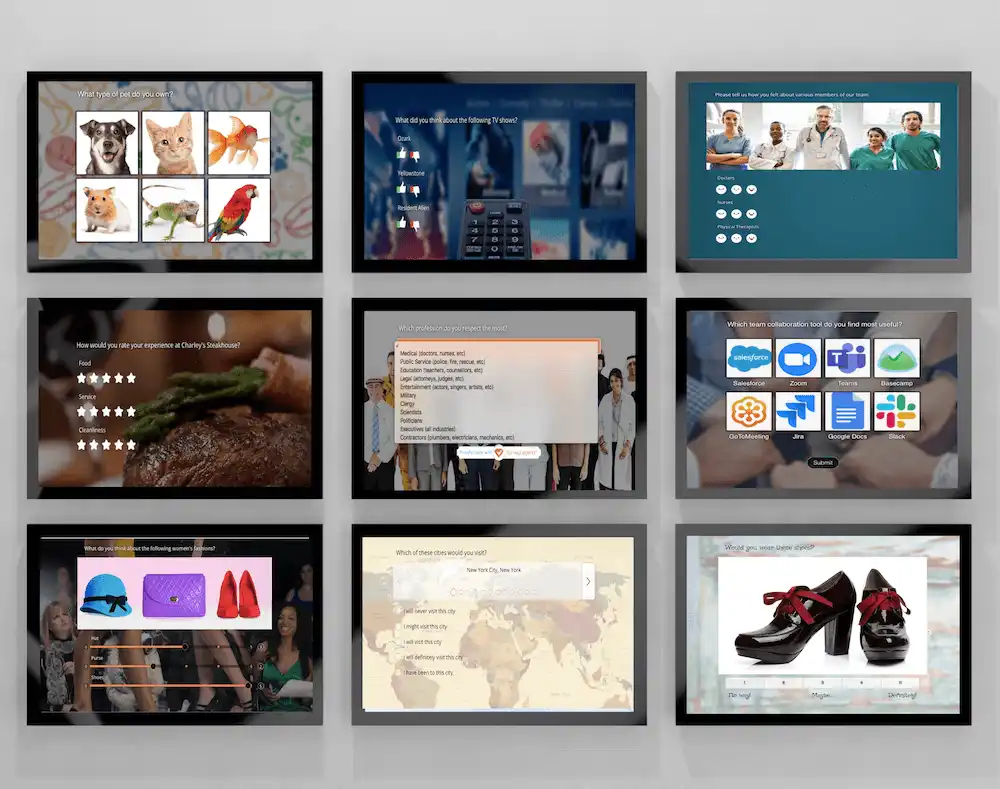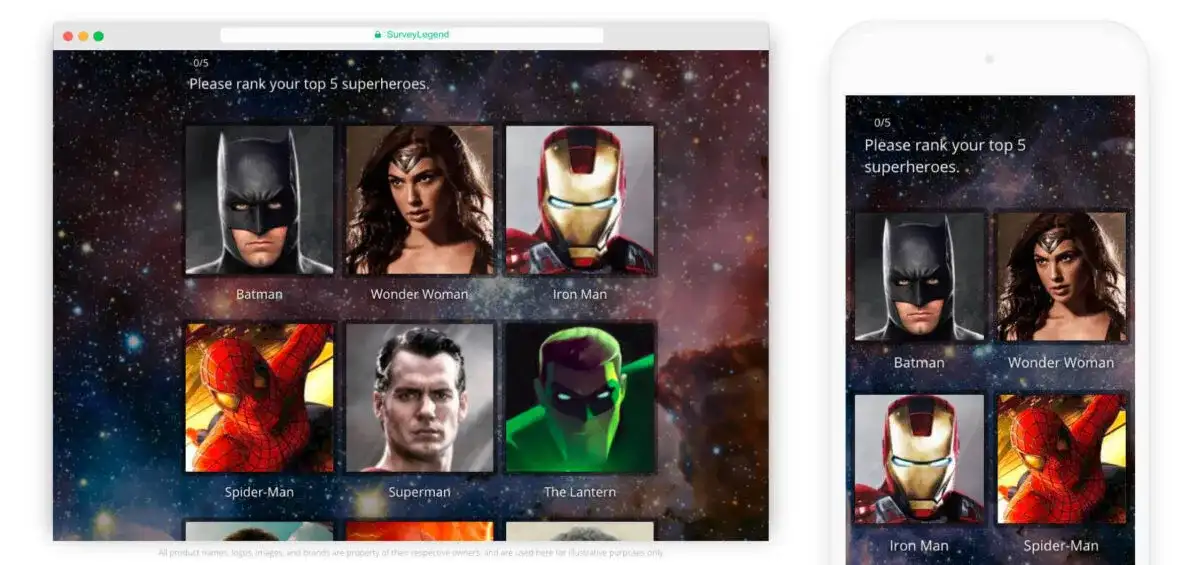Surveys are powerful tools for gathering actionable insights, but the quality of results depends heavily on the types of questions used. Beyond traditional yes/no or multiple choice, today’s surveys offer diverse formats that boost engagement and data accuracy. Options include image-based multiple choice, thumbs up/down, star ratings, emoji rankings, sliders, dropdowns, opinion scales, matrix questions, NPS, open-ended responses, picture ranking, Likert scales, and dichotomous questions. Each type serves a unique purpose, from capturing quick quantitative data to uncovering deep qualitative insights. By mixing question formats thoughtfully, organizations can improve response rates, reduce survey fatigue, and collect balanced, meaningful feedback.
When it comes to survey questions, you have a whole host of options available to you. Today, types of survey questions go far beyond the traditional yes/no and multiple-choice variety (although they’re still great options). So, let’s look at some sample survey questions that you may want to consider – and why – for your next online survey, poll, or questionnaire. Selecting the appropriate question format for your next survey is essential to maximize response quality and ensuring you collect meaningful data. Careful planning of the question format for your next survey is crucial for gathering valuable insights.
Surveys are powerful tools for collecting meaningful data. By selecting the right question types—ranging from multiple choice to open-ended—organizations can improve response rates, capture both quantitative and qualitative insights, and make better, data-driven decisions.
Create your award survey, form, or poll now!
Introduction to Surveys
Surveys are one of the most effective ways to gather valuable insights directly from your survey respondents. Whether you’re aiming to boost customer satisfaction, understand your target audience, or measure employee engagement, well-designed surveys can provide the data you need to make informed decisions. By asking the right survey questions, organizations can uncover trends, identify areas for improvement, and better understand the needs and preferences of the people they serve. With so many types of survey questions available, it’s easier than ever to tailor your approach and collect meaningful feedback that drives real results.
Survey Design: Laying the Foundation for Effective Surveys
A successful survey starts with thoughtful survey design. The way you structure your survey—including the types of survey questions you use and the answer choices you provide—can make a big difference in the quality of your results. Multiple choice questions are great for collecting quick, quantitative data, while open-ended questions allow for more detailed, qualitative insights. Likert scale questions are perfect for measuring attitudes and opinions on a numerical scale. By mixing different question formats and carefully considering your response options, you can create a survey that’s both engaging and easy to complete. Good survey design not only improves response rates but also ensures you’re collecting accurate, actionable data that truly reflects your audience’s views.
Writing Survey Questions: Tips for Clarity and Impact
Crafting effective survey questions is key to gathering meaningful, reliable data. When writing survey questions, always keep your target audience in mind and use language that’s clear and straightforward. Closed-ended questions, such as multiple choice questions and Likert scale questions, are ideal for collecting quantitative data and making analysis easier. Open-ended questions, on the other hand, give respondents the freedom to answer in their own words, providing richer, more nuanced feedback. To get the best results, avoid biased questions, double-barreled questions (which ask about two things at once), and any wording that might lead respondents toward a particular answer. By focusing on clarity and relevance, you’ll create survey questions that deliver valuable insights and help you achieve your research goals.
Create your award survey, form, or poll now!
14 Different Types of Survey Questions and When to Use Them
Survey methodology – the study of survey methods and the sources of error in surveys – reveals that respondents crave variety in the types of questions they answer. Sometimes, asking the same question across different survey questionnaires allows for benchmarking and comparison between groups or over time. Including a variety of types of questions on your surveys can make them more engaging to participants, increasing response rates. Survey questionnaires can be structured to include both unique and repeated questions, which is useful for effective performance evaluation. Variety also reduces “survey burnout,” in which participants drop out at some point during the survey because they grow bored with it. Here are twelve types of survey questions and when to use them, along with survey question examples using SurveyLegend.
1. Multiple Choice Questions
We don’t need to explain what these are; they’re just like those quizzes you took in school and have been taking ever since! There are some special things to know about SurveyLegend’s multiple choice questions, however. With our online surveys, each multiple-choice question can be customized to allow participants to select multiple answers if applicable, or be restricted to a single answer. If you want to limit their choice to one selection only, simply select the Single Selection survey field.
It’s important to provide clear answer options in a multiple-choice question to ensure meaningful data collection. When giving instructions to participants, specify whether they can select multiple answers, the number of answer options they should choose, or if an ‘other’ answer option is available. This helps improve data accuracy and captures responses outside of the predefined answer options.
Learn more about SurveyLegend’s multiple choice questions.
2. Multiple Choice Questions with Images
Depending on the online survey platform you’re using, you can use text-only questions, or use picture choice questions to further engage respondents. Picture choice questions use images as answer options, which enhances engagement and simplifies decision-making for respondents. SurveyLegend allows you to do both, and you can set your image questions so that respondents can select more than one answer or limit them to one answer. So why use images? There are many benefits to picture surveys. They are known to increase response rates because they are more visually engaging, can trigger memory and emotion, communicate ideas more effectively, cross language barriers, and more.
Learn more about the 7 Benefits of Picture Surveys.
Create your award survey, form, or poll now!
3. Thumb Ratings
Popularized by movie critics Siskel & Ebert, thumbs up is simply a more engaging way to get answers to a like/dislike question. Thumb ratings are a type of rating question used to gauge opinions in a simple, visual way. Plus, in this day of social media, most people are very used to voting up or down with thumbs, making these types of rating questions very common in surveys. Rating questions, such as thumb ratings, help collect quick feedback on preferences or satisfaction. Another example would be streaming services. Netflix, for example, allows you to vote thumbs up or down after watching a show in order to make better viewing recommendations based on your ratings.
Learn more about SurveyLegend’s thumb ratings.

4. Star Ratings
The Zagat Survey, commonly referred to as Zagat, really popularized the star rating system in 1979 by collecting and correlating the ratings of restaurants by diners. Today, of course, star ratings are a very common type of rating scale, especially with Google Reviews and G2 (where, coincidentally, SurveyLegend scores a 4.5!). Star ratings are popular because survey takers can easily sum them up and calculate the average value. Star ratings can also be interpreted as a numerical rating scale, allowing for straightforward calculation and comparison of results. With SurveyLegend, you can set your number of stars from three to ten.
Learn more about SurveyLegend’s star ratings.
5. Emoji Rankings
Just about everyone uses emojis these days, thanks to social media (in fact, using an emoji in a Tweet can increase engagement by 25% compared to messages without emojis). So why not use them in surveys? What are the benefits of emojis? Well, while numbers are universally understood and don’t need translation, does “5” on a seven-point scale properly capture how a respondent feels? On the other hand, facial expressions or emojis convey a sentiment, and human facial expressions are, for the most part, universally understood. Here, emojis are used in a healthcare survey, which is great for current patients who are too ill to express how they feel with words.
Read more about SurveyLegend’s Emoji Rankings, or “Smiles.”
Create your award survey, form, or poll now!
6. Slider Ratings
Sliders are unique to online surveys (after all, you can’t interact with a piece of paper!). Slider questions are an interactive survey format that allows respondents to evaluate items on a numerical scale by dragging a slider. A slider question enables respondents to answer by moving the slider to indicate their level of satisfaction or preference. This means respondents answer slider questions by providing nuanced feedback on a continuous scale, capturing more precise data on satisfaction, preferences, or behaviors. So, use online platforms to their full ability and add sliders, which allow participants to slide their approval (or disapproval) across a visual line. The interactivity makes it highly engaging, as you can see on this fashion survey. Rather than just check a box, respondents interact with your survey, which can improve response rates.
Learn more about SurveyLegend’s Slider Ratings.
NOTE: The slider survey below is live, so go ahead and try it out using the sliders!
7. Drop Down List
Dropdown lists are often used when there are a lot of potential answers in order to keep the survey looking clean and manageable. A dropdown menu is used to present multiple answer choices in a compact, space-saving format. A dropdown question displays answer options within a collapsible dropdown menu, making it ideal for long lists of options. Dropdown questions help prevent overwhelming respondents by hiding options until selected. However, they work the same as a single selection, organized in a list, versus being all visible at the same time. Take, for example, a question that asks, “What Country Are You From?” Showing all potential answers in a single selection question would be a nightmare. With the dropdown, respondents can even type in the first few letters of their country name, and they will be navigated to choices that start with that letter. Shown here is a screen capture of a drop-down survey after a participant has clicked to show options.
Learn more about SurveyLegend’s Drop Down Lists.
8. Opinion Scale
An opinion scale is commonly known as the Likert scale, named after American social scientist Rensis Likert. It is considered one of the best survey tools for researching popular opinions, which is why it’s often used for customer satisfaction surveys or marketing research surveys. On a Likert scale, a person selects one option among several that reflects how much they agree with a statement. Typical response options include ‘strongly agree’, ‘strongly disagree’, and a neutral midpoint, allowing for varying levels of agreement or disagreement. Likert scale questions are often answered by selecting the option that best reflects the respondent’s opinion. Using clear response options like these helps generate more accurate responses by making it easier for participants to express their true attitudes. The example below has fun with it, with a scale that goes from “No way!” to “Definitely!”
Learn more about SurveyLegend’s Opinion Scales.
9. Matrix Questions
A matrix question is a survey format that presents multiple related questions in a grid or table, allowing respondents to answer each item using the same response options. Survey makers often use matrix questions because they’re easy to write and can make a survey seem shorter than it actually is, which is important since studies show that response rates improve the shorter a survey appears. However, answering matrix questions on a mobile device can be challenging due to the limited screen size, making the grid format confusing or difficult to navigate. Additionally, if the same response options are too restrictive, matrix questions may limit respondents’ ability to fully express their opinions, potentially impacting data quality. At SurveyLegend, we do things a little differently and more efficiently! Rather than present a grid, SurveyLegend matrix questions present participants with one main question with multiple options listed in a scrolling horizontal bar; the answers for each option remain the same.
Learn more about SurveyLegend Matrix Questions.
NOTE: It’s easier to understand how our Matrix Survey works by seeing it in action. The example below is live, give it a try!
Create your award survey, form, or poll now!
10. NPS Questions
The NPS question type measures customer and employee loyalty by calculating an NPS score. It ranges from -100 to 100, and is calculated by asking customers how likely they would be to recommend your product or service to a friend or colleague, using numerical values provided by respondents on a scale from 1 to 10. It’s important to know that on NPS questions, based on their answers, respondents are either considered:
- Promoters (score of 9 and 10) are your most enthusiastic and satisfied customers who may actively promote your company.
- Passives (score of 7 and 8), customers who don’t feel strongly one way or another.
- Detractors (score of 0 to 6) are customers who won’t recommend your company and may talk poorly about it.
The resulting numerical data helps companies improve their products or services to increase their score, thus building customer loyalty and creating enthusiastic brand advocates. They can try to turn passives into promoters, or try to solve issues for detractors so that they don’t actively badmouth their brand.
Read more about SurveyLegend NPS Questions.
11. Open-Ended Questions
While entire surveys composed of open-ended questions are sure to frustrate participants and become an analysis nightmare, when used sparingly, an open-ended question can elicit detailed responses that offer deeper insight into questions you’ve already asked in another format. Open-ended questions encourage more meaningful answers and provide qualitative data that helps you understand customer insights, opinions, and suggestions for improvements. Meaningful answers from open-ended questions can lead to more actionable feedback. They’re also a good way to conclude a survey, giving participants space to type any additional information, thoughts, or concerns they may have.
Read more about How to Use Open-Ended Questions on Surveys.
12. Picture Ranking
Last but not least, picture ranking is a type of rank order question that asks respondents to rank images, allowing them to prioritize options based on their preferences. These ranking questions help reveal the relative importance of different choices by letting respondents vote on pictures, highlighting their most and least preferred options. Rank-order questions like picture ranking are especially useful for understanding preferences and decision-making processes, making them valuable for gathering insights into user priorities.
Learn more about SurveyLegend’s Picture Rankings.
NOTE: Want to try out our Picture Ranking Survey? It’s live, give it a go below!
13. Likert Scale Questions
Likert scale questions are a popular type of survey question used to measure attitudes, opinions, and perceptions. These questions ask respondents to rate their level of agreement or disagreement with a statement using a numerical scale—often ranging from 1 to 5 or 1 to 7. Likert scale questions are widely used in online surveys because they provide a simple, standardized way to collect quantitative data on customer attitudes and customer sentiments. Whether you’re measuring satisfaction, gauging employee engagement, or tracking changes in public opinion, Likert scale questions can help you gather valuable insights that inform your decision-making. By analyzing responses across the scale, you can identify trends and better understand how your audience feels about key issues.
14. Dichotomous Questions
Dichotomous questions are straightforward survey questions that offer respondents just two answer choices—such as yes or no, true or false, or agree or disagree. These questions are commonly used in multiple-choice questions and rating scale questions to collect clear, binary data. Dichotomous questions are especially useful when you need quick, decisive answers or want to filter respondents based on a particular answer. By including dichotomous questions in your survey, you can simplify the response process and gather data that’s easy to analyze, helping you make informed decisions based on your audience’s preferences and opinions.
Create your award survey, form, or poll now!
How Many Types of Survey Questions Should You Use on a Survey?
As you can see, SurveyLegend offer many types of survey questions that you can use to create your survey. You can also use every type of survey question on your survey. But just because you can, should you? You may want to conduct some A/B testing to see what gets you the most responses. In our experience, it’s important to use a few different types of questions to keep respondents on their toes. By engaging with different types of questions, you can obtain better answers and more actionable insights from your respondents. Carefully selecting question types also improves the quality of the survey data collected. However, you also don’t want to overwhelm them with too many types of survey questions. This is likely to frustrate and confuse them. It’s best to choose a happy medium!
Conclusion
Online surveys have come a long way, and SurveyLegend is leading the way in innovation! Today, with researchers, marketers, and others using online surveys to understand and engage with people, it’s important to keep things fresh. By using a variety of types of questions for your surveys, you can capture people’s attention – and better results! To make any of these surveys – or all of them! – count on SurveyLegend for beautiful picture polls and surveys with images. Start today for free!
What types of questions do you use for surveys? Do you incorporate picture questions into your surveys? Please provide feedback on which survey questions you find most effective and let us know which survey methodology works best for you!
Create your award survey, form, or poll now!
Frequently Asked Questions (FAQs)
What types of survey questions are there?
For online surveys, researchers and marketers have their choice of questions, including multiple-choice, multiple-choice surveys with images, ranking surveys (thumbs, stars, emojis, sliders), Likert-scale questions, open-ended questions, NPS questions, picture rankers, and more. Demographic questions are also commonly used to gather background information about respondents, which helps with audience segmentation and targeted strategies. Dichotomous questions provide binary answers (such as yes/no), allowing for quick and clear responses. Surveys are widely used in market research to help organizations understand customer needs, satisfaction, and employee engagement. Both qualitative and quantitative research methods are used in survey design to collect comprehensive data. It’s important to avoid loaded questions, which can introduce bias and skew results, and to be aware of social desirability bias, where respondents may answer sensitive questions in a way they think is more socially acceptable. Clear wording in survey questions is essential to facilitate accurate answering and improve the quality of responses.
Why should you use a variety of types of survey questions?
Good survey questions mix things up in order to keep things interesting for the respondent (but don’t use too many in each survey, or it can become confusing). By using a variety of types of questions, you can engage respondents and keep them on their toes (so that they don’t fall into a pattern of always selecting C on a multiple-choice survey, for example).
What are the benefits of surveys that use picture questions?
Picture questions help trigger participants’ memory and emotional response, leading to higher levels of engagement and more accurate results.











